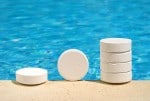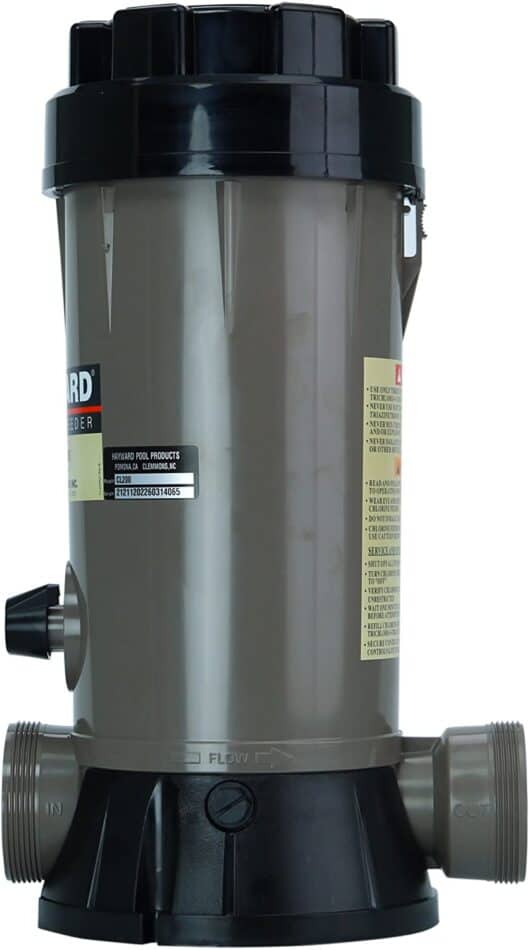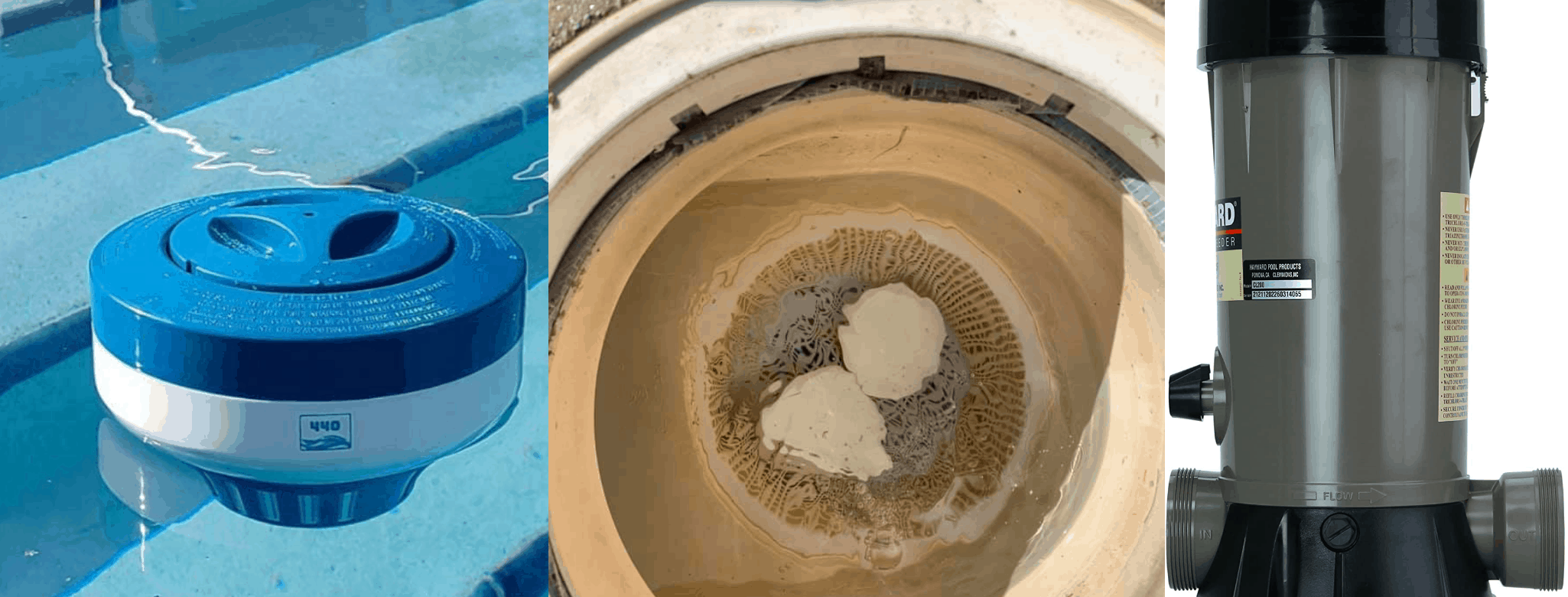The subject of where to leave chlorinating tablets safely in a swimming pool has been a source of confusion for swimming pool professionals and owners alike. As a swimming pool service professional of more than fifteen years, I have seen a number of scenarios, so in this article, I would like to offer some clarity with factual data as support, and I would like to dispel some of the myths and incorrect instruction that has been offered on blogs, vlogs, and social media sites and other forums out there.
Let’s talk about where you can safely leave chlorine tablets in your swimming pool.
Swimming pool tablets (pucks) are best placed in either a tablet floater or an erosion-style in-line chlorinator. Chlorine tablets are designed to be used with both of these systems. While an erosion feeder has a constant flow of water from the pool pump, a floater allows the tabs to slowly erode gradually.
Chlorine tablets have gained popularity over the years as a primary source of chlorination for swimming pool owners. But, are chlorine tablets safe to use? Why not just put them in the skimmer basket of the pool? What exactly is an erosion feeder? Are there any drawbacks to using chlorine tablets as a primary source of chlorination? Let’s go ahead and answer these questions and dive into the subject of chlorine tablets.
What Makes Chlorine Tablets Dangerous?

Like any chemical, chlorine has associated dangers. The solid form of chlorine such as tablets and granular chlorine can give some a false sense of safety. Here are some facts about two types of chlorine tablets to keep in mind when it comes to their safe use.
Safe handling of Trichlor Chlorine Tablets
The primary chemical compound used for chlorine tablets is known as trichloro-s-triazinetrione or trichloroisocyanuric. In the industry, we just call it trichlor. Trichlor is known as a stabilized form of chlorine, meaning that other chemicals are added to protect the chlorine from being degraded by UV rays, see this article about CYA for more on that.
Referring to a type of chlorine as stable has nothing to do with it being safe for human handling. Trichlor has 90% available chlorine, which is the highest available chlorine you can get for consumers, which is also why it is such an efficient form of chlorine to use.
Trichlor chlorine tablets have a pH of approximately 3.0 which makes them a very acidic form of chlorine. As a point of reference, the human eyes like a pH of about 7.4, and our skin is nearly 5.0. Being that the pH scale is logarithmic that makes trichlor tablets nearly 1000 times more acidic than our skin can safely handle.
Diluted in a large body of water, like say…a pool, the low pH and high chlorine content will find a natural equilibrium and if kept within proper ranges will be relatively harmless to us humans. So yes, trichlor chlorinating tablets are safe to use in a swimming pool, in fact, they are a great source of chlorine.
The high chlorine content and acidic pH, however, make these tablets dangerous to handle without gloves. Will they burn you? If they are dry out of the bucket, probably not. Extended contact, however, is probably something that is not recommended. It is never a bad idea to use gloves when adding tablets to the pool.
Safe handling of Cal Hypo Chlorine Tablets
Another less common chemical used for chlorine tablets is known as calcium hypochlorite. In the industry, we just call it Cal Hypo. Cal Hypo is known as an inorganic form of chlorine, meaning that no other chemicals have been added to the chlorine.
Cal hypo chlorine tablets have a pH of approximately 11.8 which makes it a very basic, or alkaline form of chlorine. So calcium hypochlorite is on the opposite side of the pH scale from the trichlor tablet. That doesn’t make them any safer, it just means you have to handle it accordingly.
Cal hypo comes in varying strengths, either 65%, 70%, or 75%. Most of what I have seen on the market in tablet form is 70% strength. Not quite as potent chlorine as trichlor, but still strong enough to be an efficient sanitizer and oxidizer.
Though cal hypo is on the basic side of the pH scale, safe care needs to be taken. Care should be taken as the chlorine and basic nature can also make handling these tablets dangerous. An added danger is that is much more reactive than trichlor and will actually react to trichlor and other organic materials. In the pool industry, we often hear horror stories of people using cal hypo in a container that was previously used for trichlor and the ensuing fires and explosions.
So care must be taken to make sure cal hypo isn’t being mixed with other materials, like other chemicals. But don’t let that scare you. Cal Hypo is also an efficient source of chlorine and is another excellent option for chlorine tablets if used correctly.
Whether using trichlor or cal hypo it is never recommended that they come in contact directly with the swimming pool surface or equipment. Much in the same way you need to be cautious when handling chlorine tablets, caution needs to be taken when putting them to use to prevent damage to the swimming pool.
Where Should You Put Chlorine Tablets In Your Swimming Pool
It would seem that there is any number of options on where to place chlorinating tablets. After all, they are conveniently packaged to slowly dissolve so theoretically you could place a tablet on the steps of the pool, you could use the ‘soap-on-a-rope’ method by tying a tablet to the railing, or you could put a tablet in the skimmer basket or three or four, or you could put a couple of tablets in the filter pump basket even.
At this point, you probably think I’m using hyperbole to make a point. I wish I was. In my years running a pool service, I’ve seen all of these examples and more. Oddly enough I have had people arguing this point in the comment section of my youtube video about this topic.
So what is the correct way to use chlorinating tablets in a swimming pool?
Regardless of cal hypo or trichlor tablets, there really are only two options, but I’m going to address a third popular option as well.
1. The Best Option Is To Use A Plumbed Erosion Feeder

Erosion chlorinators are designed to hold trichlor tablets primarily. (Although they are hard to find, there are a few cal hypo erosion feeders on the market.) In an erosion feeder, the water from the filter pump slowly flows through the erosion chamber which obviously erodes the chlorine tablet as it slowly dissolves under the control of a flow valve and distributes chlorine evenly throughout the pool by means of the pool’s own plumbing return lines.
Why is this the best option? The pool operator can control the amount of erosion taking place usually by means of a dial or some other form of control flow control valve. The chlorine and other ancillary chemicals in the tablets are then distributed evenly throughout the pool which means there is less opportunity for pockets of stagnant water containing high amounts of chlorine thus increasing bather safety.
An erosion chlorinator is a great option also because it’s a permanent fixture on the equipment pad that can be serviced and maintained and last a good long time. (many years if maintained properly) They are generally built to hold up to the rigors of the water pressure and chemical environment that they were made for. If you plan on installing any erosion chlorinator, make sure to install it after all the rest of your equipment is on the return side of the equipment pad. Check out this Hayward CL200 from Amazon.
If you aren’t sure if your erosion feeder is designed to hold cal hypo tablets, refer to your user’s manual as most manufacturers will clearly state if the feeder is designed for cal hypo. If trichlor tablets were ever used in a feeder DO NOT USE CAL HYPO.
Depending on your setup, however, an erosion chlorinator may not be an option for you. Many folks have to winterize their pools every year and in many cases have temporary equipment pads that won’t allow for a permanent fixture like a chlorinator to be installed. So what option is available for you all?
2. The second best option is to use a floating chlorinator (chlorine dispenser)

Like erosion chlorinators, chlorine dispensers are designed to hold trichlor tablets. If you’ve been around a pool for very long you have likely seen one of these floating around in the pool. The traditional color is blue and white, like the one found on Amazon. Most will hold two or three tablets at a time, some being extra capacity can hold up to 7 tablets. There’s a lid on the top with slits on the bottom. Just like the name implies it floats around the pool slowly dissolving chlorine tablets throughout the pool.
Throughout the summertime, chlorine tablet floaters are a good option. Because of the warmer weather and higher demand, the chlorine tablets tend to dissolve fairly quickly and they distribute the chlorine pretty evenly. A tab floater is a great option where an erosion chlorinator either wouldn’t make sense or just isn’t an option.
There are a couple of drawbacks to tab floaters.
If there is a pool cover being used the tab floater can’t really move around to distribute the chlorine. In such a case I have seen chlorine burns on a pool cover from a tab floater sitting underneath it for extended periods of time. Sometimes the tab floater will get hung up between a cover and a pool wall which can also lend to potential staining on the pool wall itself. This is especially true if you are using cal hypo tablets as they tend to bleach vinyl and fiberglass badly.
Another drawback is that you can’t control the rate of dispensing. Most tab floaters have adjustable slits in the sides of them, but they either work or they don’t there really is no controlling the rate of flow.
Another issue with tab floaters is that they go with the flow…literally, so they will inevitably find their way to the skimmer opening just like anything else that’s floating on the surface. This is something to watch for because it can cause a clog or starve your pump for water.
Many of these issues can be overcome by tying the floater by means of a string to a stationary safe location within the pool.
Because the floater is able to move around and contains high levels of chlorine and acid, it is highly recommended that the tab floater be removed from the pool when there are swimmers present. Just remember to put it back in the pool afterward.
3. A Skimmer Basket Is The Worst Possible Place For Tabs
This shouldn’t even be considered an option. The only reason I’m addressing it is that there are so many blogs or forums and YouTube videos that say this is a good place to put a chlorinating tablet. In fact, the current number 1 search result says this is the BEST option.

As I’ve already mentioned several times trichlor tablets are highly acidic and cal hypo tablets are highly alkaline and high in calcium. What that means is that the water that flows over them takes on the concentrated chemicals of the tablets. Any water that goes through the skimmer or the pump goes through every other part of the pool system. Over time this water will corrode, or calcify internal pump parts, internal filter parts, internal heater parts, in anything else within the pool equipment system.
Do not, I repeat do not put chlorinating tablets in any vessel that is not designed to hold them. To this point, every bucket of chlorinating tablets that I have laid eyes on has verbiage within the warnings that say not to use these in a skimmer basket. Even CCH who is a manufacturer of cal hypo tablets recommends using their cal hypo feeder. Which is why I can happily stand behind their calcium hypochlorite tablets.
I wish I could say this more politely, but it does dishearten me to a great degree that there continue to be people in my industry that make recommendations that actually harm the product that they are supposed to be taking care of. So if you take one thing away from this article it should be not to put chlorinating tablets in the skimmer basket. Aside from that, is there any reason not to use chlorinating tablets?
Chlorine Tabs In The Pool Skimmer Could Ruin Your Pool
Drawbacks Chlorinating Tablets As A Primary Source of Chlorine?
Because they tend to be pretty easy to store and administer many people like the idea of using chlorine tablets as their primary source of chlorine. Not a bad line of reasoning, right? Well, sort of…
Remember early in this article I mentioned that there are other materials included in the trichlor tablet. One of those materials is called cyanuric acid. In the right amount, cyanuric acid is a good thing in your pool. Again, go check out this other article to understand cyanuric acid a little better. It’s understood that once a certain threshold is crossed, right around 50 parts per million, cyanuric acid starts blocking the effectiveness of chlorine.
So what does that have to do with using tablets as your primary form of chlorine? Well because trichlor tablets are actually 55% by volume cyanuric acid it won’t take very long to reach a high threshold of CYA that actually can render available chlorine ineffective. You might wonder, why not just wait for the CYA to burn off? that’s a great question, and unfortunately, the answer is that CYA does not burn off. It remains in the pool until physically removed, either on the bodies of bathers or when the water is drained out of the pool.
It’s for that reason that we have always recommended using chlorine tablets as a secondary means of chlorine rather than primary. Usually, we use liquid chlorine which is a non-stabilized form of chlorine or a salt-chlorine generator is best. Stay tuned for a write-up on SCG (Salt Chlorine Generators.
Calcium Hypochlorite tablets aren’t much better. Even though they don’t contain cyanuric acid, they do contain a lot of calcium. So as you add tablets you are adding to your water hardness. Like CYA, calcium doesn’t evaporate out of pool water. If anything, calcium likes to find its way to heaters and clog them up, and in really bad cases it will attach to pool walls.
Something to consider also is that as of the time of this article, prices on chlorine tablets are on the rise here in the US due to the BioLab chlorine plant fire in August 2020. According to Orenda’s blog “Sources in the industry estimate the plant was responsible for at least one-third (1/3) of trichlor production in the country.” This will likely spell rate hikes across the entire industry, in fact, some are already starting to hit here on the west coast of the US. The only way to combat the increase is to have your own form of chlorine production or to not need as much, to begin with. Stay tuned as I address both of these topics in upcoming articles.
Check out the next article to see where pool algae come from and how to manage it.
Tim K. is a residential swimming pool specialist since 2008. He has multiple certifications in pool operations, chemistry maintenance, and related fields. As a swimming pool maintenance service company owner and operator he has a clear understanding of what is currently on the minds of swimming pool owners. His involvement within the professional swimming pool community as an active member of IPSSA and former Fremont, CA Chapter Secretary helps provides a clear understanding of the latest technology and keeps his training up to date and current.
Recent Posts
The Origin of Green Algae in Swimming Pools: Unveiling the Culprit
Swimming pools are synonymous with relaxation, fun, and refreshing dips during hot summer days. However, the appearance of green algae can turn this enjoyable experience into a frustrating one. Green...
At the heart of every pool is a filter pump that needs to be run every day for a specified length of time. Rather than try to remember to turn a pool pump on and off every day, pool builders and...


